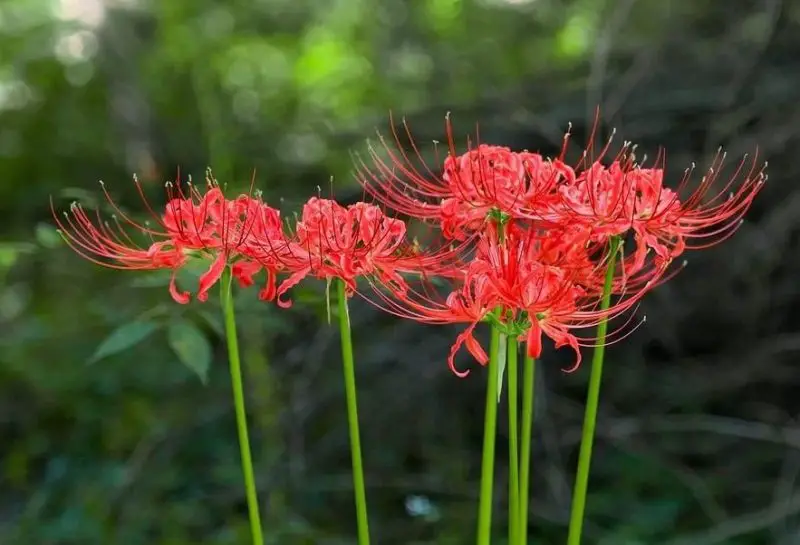The red spider lily, or Lycoris radiata, makes a striking appearance as most plants start to lose their foliage for the winter. This eye-catching flower, which is a member of the amaryllis family, brightens gardens with its vivid red flowers throughout late summer and early autumn.
This guide provides comprehensive tips on growing and caring for red spider lilies, ensuring your garden stays colorful during the cooler months.
Key Facts About Red Spider Lily

- Common Names: Red spider lily, naked lily, hurricane lily
- Botanical Name: Lycoris radiata
- Family: Amaryllidaceae
- Plant Type: Perennial herbaceous
- Mature Size: 1-2 feet tall, 12-18 inches wide
- Sun Exposure: Full sun to partial shade
- Soil: Well-drained, sandy, or loamy
- Bloom Period: Late summer to early fall
- Flower Color: Red
- USDA Hardiness Zones: 6-10
- Native Region: Asia
- Toxicity: Poisonous to humans and pets
Essential Care Tips for Red Spider Lily
Light Conditions for Optimal Growth
The red spider lily thrives in both full sunlight and partial shade, but blooms are generally more vibrant when the plant receives partial shade. Under partial shade, flowering tends to occur earlier, making this a preferred condition for gardeners looking to enjoy early blooms.
Best Soil Types for Red Spider Lily
Ensure your red spider lily is planted in well-drained soil enriched with organic matter. For optimal flowering, position the bulb with its neck slightly protruding above the soil surface. Although the plant prefers sandy or loamy soil, it can adapt to various soil types as long as the drainage is sufficient.
Watering Guidelines
During the summer, when the red spider lily is dormant, avoid overwatering to prevent bulb rot. Once the growing season starts, typically in late summer, keep the soil moderately moist. Adhere to the “1 inch of water per week” guideline for healthy blooms, ensuring the soil doesn’t become waterlogged.
Ideal Temperature and Humidity
The red spider lily is hardy in zones 6 to 10. In colder zones (6 and 7), protect the bulbs and leaves from freezing by adding a layer of mulch. In warmer regions, the foliage often stays evergreen throughout the winter, dying back only in spring.
Fertilizer Application for Red Spider Lily
To keep your red spider lilies healthy and blooming, fertilize twice a year. Apply a high-nitrogen fertilizer in the spring to encourage growth, and after blooming in late summer or early fall, switch to a potassium and phosphorus-rich fertilizer to boost root development and enhance winter hardiness.
Varieties and Cultivars of Red Spider Lily
The red spider lily has a few notable varieties and cultivars that gardeners may want to consider:
- Lycoris radiata var. radiata: The most common type, which spreads quickly through bulb division. It’s a great choice for naturalizing.
- Lycoris radiata var. pumila: A smaller, less common variety that propagates via seeds.
- ‘Fire Engine’: Known for its classic, intense red flowers.
- ‘Red Sunset’: Features blooms with a reddish-pink hue.
Trimming and Pruning Red Spider Lily
While red spider lilies do not require regular pruning, you may be tempted to tidy up the plant. However, avoid cutting back the foliage while it is still green or yellowing, as this is the time when the bulbs are absorbing nutrients for future blooms. Prune only after the leaves have fully withered and dried.
How to Propagate Red Spider Lily
Propagating red spider lilies is a straightforward process since they reproduce through bulb division. The best time to divide the bulbs is during the plant’s dormant phase in the summer. Here’s a quick guide:
- Water the soil around the bulbs to loosen it.
- Carefully dig up the bulbs with a spade.
- Separate the bulbs by gently pulling them apart.
- Replant the bulbs 6 to 8 inches apart in their new location.
- Water the newly planted bulbs to help them settle.
Growing Red Spider Lily in Containers
If you live in colder climates (zones 6-7), consider growing red spider lilies in large, deep containers. Use soil that is rich in organic matter and well-drained. Ensure that the top part of the bulb is slightly above the soil for proper flowering. Space the bulbs 6 to 8 inches apart, just as you would in a garden bed.
Protecting Red Spider Lily from Cold Winters
In areas where winters are harsh (zones 6 and 7), protect your red spider lilies by applying a thick layer of mulch in the fall. This helps to insulate the bulbs from freezing temperatures. If the plants are in containers, move them indoors for the winter to avoid frost damage.
Common Issues: Pests and Diseases
One of the best things about growing red spider lilies is their resistance to most pests and diseases. Additionally, they are deer-resistant, making them an excellent choice for gardens in areas where wildlife can be an issue. Just be cautious of overwatering, which can cause bulb rot.
Encouraging Red Spider Lily to Bloom
Be patient with your red spider lilies, as it may take a year or two for the bulbs to establish and bloom. The most common reasons for non-flowering include planting the bulbs too deeply or experiencing an unusually cold winter. Make sure the bulb neck is exposed above the soil to encourage blooms.
How to Promote More Blooms
For vibrant and plentiful blooms, ensure that your red spider lilies have nutrient-rich soil and are fertilized twice a year. Feeding the plant with a nitrogen-rich fertilizer in the spring and a phosphorus-rich one after flowering can lead to better growth and more flowers.
Bloom Time and Duration
The red spider lily typically blooms between July and September, with the flowers lasting for up to two weeks. Healthy bulbs will shoot up stalks that produce clusters of brilliant red flowers during these months.
Appearance and Fragrance of Red Spider Lily Flowers
The flowers of the red spider lily are known for their long, thin, curved petals that resemble spider legs, which is how the plant gets its name. The blooms are a deep, rich red but fade to a soft pink as they age. These lilies emit a gentle, sweet fragrance, adding to their charm.
Conclusion
The red spider lily is a spectacular plant that adds a dramatic burst of color to your garden in late summer and early fall. With the right care, including well-drained soil, moderate watering, and regular feeding, these plants will thrive and reward you with their stunning red flowers year after year. Whether planted in the ground or containers, red spider lilies are a must-have for any gardener looking to extend the beauty of their garden into the cooler months.






